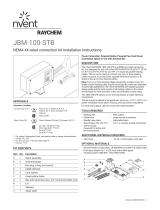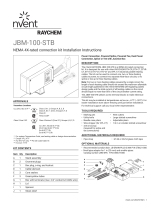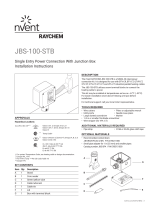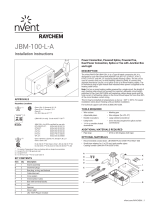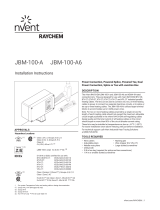
Connection Kit for Division 1 Hazardous
Locations Installation Instructions
HAK-C-100

DESCRIPTION
The nVent RAYCHEM HAK-C- is a connection kit designed for use
in Division hazardous locations with the
RAYCHEM
industrial heating
cables listed on page of these instructions. The kit contains materials
for sealing one heating cable entry when making a power, splice, tee, or
end termination. A heat-shrinkable core seal is provided specifically for
use with LBTV-CT heating cables. For all other heating cables, a CS-
cold-applied core seal is provided.
Refer to the Heat-Tracing Systems Design and Installation Guide for
Hazardous Div. Locations (H) for assistance in the design of each
heat-trace system. For technical support call nVent at () -.
This component is an electrical device that must
be installed correctly to ensure proper operation
and to prevent shock or fire. Read these important
warnings and carefully follow all of the installation
instructions.
• To minimize the danger of fire from sustained
electrical arcing if the heating cable is
damaged or improperly installed, and to
comply with
nVent
requirements, agency
certifications, and national electrical codes,
ground-fault equipment protection must
be used. Arcing may not be stopped by
conventional circuit breakers.
• Component approvals and performance are
based on the use of nVent-specified parts only.
Do not substitute parts or use vinyl electrical
tape.
• Keep components and heating cable ends dry
before and during installation.
• The black heating cable core and fibers are
conductive and can short. They must be
properly insulated and kept dry.
• Damaged bus wires can overheat or short. Do
not break bus wire strands when scoring the
jacket or core.
• Use only fire-resistant insulation materials,
such as fiberglass wrap or flame-retardant
foam.
• Heat-damaged components can short. Use
a heat gun or a torch with a soft, yellow,
low-heat flame. Keep the flame moving to
avoid overheating, blistering, or charring the
heat-shrinkable tubes. Avoid heating other
components. Replace any damaged parts.
Health Hazard: Prolonged or repeated contact with
the sealant in the core sealer may cause eye or
skin irritation. Wash hands thoroughly. Overheating
or burning the sealant will produce fumes that may
cause polymer fume fever. Avoid contamination of
cigarettes or tobacco. Consult MSDS VEN 0058 for
further information.
Overheating heat-shrinkable tubes will produce
fumes that may cause irritation. Use adequate
ventilation and avoid charring
or burning. Consult MSDS RAY3122 for further
information.
CHEMTREC 24-hour emergency telephone:
(800)424-9300
Non-emergency health and safety information:
(800) 545-6258.
CAUTION:
Item Qty Description
A HAK sub-assembly: sealing fitting,
nipple, and plugs
B Union
C Packing fiber
D Sealing compound
E Tubing clamp
F Compression gland with screws
G Compression gland with threaded
inserts
H Grommets (B, C, E, K, R)
I Flex tube
J Terminal block (max: AWG wire)
K Black heat-shrinkable tubes
L Clear yellow heat-shrinkable tube
M Green/yellow tube
N CS- core sealer
A
B
C
D
E
F
G
H
I
J
K
L
M
N
APPROVALS
(1)
Except VPL.
(1)
Hazardous Locations
Class I, Div. 1, Groups B, C, D
Class II, Div. 1, Groups E, F, G
Class III
WARNING:
TOOLS REQUIRED
• / in drive ratchet
• Marking pen
• Diagonal cutters
• Utility knife
• Needle nose pliers
• / in hex key
• / in slotted screwdriver
• Ruler
• / in hex key
• Pipe wrenches ( required)
• / in hex key
• Wire strippers (for VPL only)
• Vdc Insulation Resistance
Tester
• Heat gun or minitorch (required if
heat-shrinkable core seal is used)
ADDITIONAL MATERIALS REQUIRED
• Junction box: RAYCHEM HAK-JB- or agency-approved Division
hazardous location / in NPT junction box. Junction boxes other
than the HAK-JB- may not be compatible with the RAYCHEM
universal mounting bracket.
• Small volume of water
• Universal mounting bracket (UMB)—one per junction box
• Pipe strap—one per mounting bracket
KIT CONTENTS
nVent.com | 2

WARNING: Reusing the grommet or using the wrong grommet can cause leaks, cracked components, shock, or fire.
Be sure the grommet you select is correct for the heating cable you plan to install. Use a new grommet whenever the
heating cable has been pulled out of the termination.
General Instructions
• The HAK-C- connection kit is for use only with the following heating cables: BTV, HBTV, QTVR, HQTV, XTV, HXTV, LBTV,
FHP and VPL (-CT versions). Do not use this kit with any other heating cables.
• Select correct grommet from table on right. The grommet I.D. letter is embossed on each grommet.
Heating Cable
for FM Only Grommet
HBTV-CT B
HBTV-CT B
HBTV--CT E
HBTV--CT E
HBTV-CT E
HBTV-CT E
HQTV-CT C
HQTV-CT C
HQTV-CT E
HQTV-CT E
HXTV-CT R
HXTV-CT R
HXTV-CT R
HXTV-CT R
Heating Cable
for FM Only Grommet
HXTV-CT R
HXTV-CT R
HXTV-CT R
HXTV-CT R
FHP- E
FHP- C
BTV-CT B
BTV-CT B
BTV--CT E
BTV--CT E
BTV-CT E
BTV-CT E
QTVR-CT C C
QTVR-CT C C
Heating Cable
for FM Only Grommet
QTVR-CT E
QTVR-CT E
All XTV-CT-T R
All XTV-CT-T R
All XTV-CT-T R
All XTV-CT-T R
All VPL-CT R
All VPL-CT R
LBTV-CT K
GROMMET SELECTION
Inserts
Cut
• Fasten the RAYCHEM universal mounting bracket (UMB)
or suitable mounting plate for another junction box to
the pipe at the desired location. Be sure the pipe strap
isunder the heating cable.
• Mount box on bracket.
• Thread male half of union into box entry.
• Assemble union halves together.
• Thread compression gland with threaded inserts into
fitting until tight.
• Thread nipple into female half of union until tight.
• Thread nipple into sealing fitting until tight.
• Measure flex tube and cut to length from gland to
pipe.
nVent.com | 3

WARNING: Correct grommet must be
used for heating cable being installed or
electrical hazard could result.
• Select correct grommet from table on
page 2.
• Slide parts onto heating cable as shown.
• Slide heating cable through fittings
andbox.
• Repeat steps 2 through 5 for each
additional heating cable.
16 in.
(41 cm)
min.
Important
For VPL-CT only:
Locate indentation
(bus wire connection)
at this point
14 1/2 in.
(37 cm)
Do Not
Cut Braid
A
• Lightly score outer jacket as shown.
• Bend heating cable to break jacket at
score, then peel off jacket.
Go to step 7.
For BTV-CT, HBTV-CT, QTVR-CT, HQTV-CT, FHP, XTV-CT, HXTV-CT, and LBTV2-CT heating cables
14 1/2 in.
(37 cm)
1/2 in.
(13 mm)
Do Not
Cut Braid
Indentation
(bus wire connection)
15 in.
(38 cm)
B
• Cut heating cable 15 in. (38 cm) from the indentation (bus wire connection).
• Lightly score outer jacket as shown.
• Bend heating cable to break jacket at score, then peel off jacket.
Go to step 7.
For VPL-CT heating cables
nVent.com | 4

A
• Cut and remove all fiber strands.
• Score and remove center spacer.
• Remove any remaining core material.
Go to step 10.
For XTV-CT and HXTV-CT heating cables
1/4 in.
(6 mm)
B
For BTV-CT, HBTV-CT, QTVR-CT, HQTV-CT, FHP and LBTV2-CT heating cables
• Notch core.
• Peel bus wire from core.
• Score between bus wires at inner jacket.
• Bend and snap core.
• Peel core from bus wire.
• Remove any remaining core material.
For LBTV2-CT go to Step A on page 11.
For all other heating cables go to step 10.
• Lightly score inner jacket around and down as shown.
• Bend heating cable to break jacket at score, then peel
off jacket.
6 1/2 in.
(165 mm)
For VPL-CT only:
• Push braid back to create a pucker.
• At pucker use a screwdriver to open braid
• Bend heating cable and work it through opening in braid.
• For VPL-CT only: Cut and remove thread.
nVent.com | 5

• Unwind heating element, cut and remove as shown.
• Lightly score clear jacket around and down as shown.
• Bend heating cable to break jacket at the score then peel off jacket.
• Remove 3/8 in. (9 mm) insulation from bus wires.
6 1/2 in.
(165 mm)
3/8 in.
(9 mm)
C
5/8 in.
(15 mm)
• Mark both sides of jacket 5/8 in. (15 mm) as shown.
For VPL-CT go to Step 11. For all other heating cables
go to Step 12.
1 1/2 in.
(38 mm)
• Cut off and discard end of core sealer legs.
For VPL-CY only
Tubes
For VPL-CT heating cables
• Refer to material safety data sheet RAY5510.
• If needed, retwist and straighten bus wires.
• Insert bus wires into guide tubes as shown.
• Make sure all strands go into tubes.
• Push core sealer onto the heating cable to
the mark made in Step 10.
• Note: Extra force may be required for
larger cables.
nVent.com | 6

• Trim bus wires (except VPL-CT).
• Trim braid.
• Slip the green/yellow tube onto the braid.
Test A
Test B
A
14 1/2 in.
(37 cm)
3/8 in.
(9 mm)
• Remove the tubes and dispose of them in a plastic bag.
Heating Cable Test 1
Following the test method outlined below, perform an insulation resistance test on the heating cable using a Vdc tester.
Test Method
• Perform Tests A and B at , , and Vdc.
• Insulation resistance criteria is defined in Step b (page ).
• If the readings vary with the voltage refer to the Troubleshooting
Guide (page ).
Test A
• Connect the test leads as shown.
• Measure the insulation resistance between the heating cable bus
wires and the braid.
• Record the Test A insulation resistance values in the “Heating
Cable Test ” section of the FM Required Division Installation
Record on page .
Test B
• Connect the test leads as shown.
• Measure the insulation resistance between the braid and the
metal pipe.
IMPORTANT:
performing Test B.
sealing fitting (as braid may contact sealing fitting or
junction box), see illustration in Post-Thermal-Insulation
Heating Cable Test , Step , page .
“Heating Cable Test ” section of the FM Required
Division Installation Record on page .
WARNING: Fire Hazard. Megohmmeter
test can produce sparks. Be sure there are
no flammable vapors in the area before
performing this test. Follow all site safety
guidelines when working in hazardous areas.
nVent.com | 7

Center
• Be sure green/yellow tubing does not
extend into sealing fitting.
• Center heating cable as shown.
• Position grommet in gland cavity.
• Tighten compression gland screws, being
careful not to change position of heating cable
in sealing fitting
(see Step 18).
• Install flex tubing onto compression
gland.
• Tighten tubing clamp.
• Carefully pull heating cable back through box,
making sure core sealer remains positioned at
5/8 in. (15 mm) mark. Continue pulling until end of
outer jacket is centered in sealing fitting opening
(see Step 18).
B
Insulation Resistance Criteria
A clean, dry, properly installed circuit should measure thousands of megohms, regardless of heating cable length
or measuring voltage(0 to 2500 Vdc). The following criteria are provided to assist in determining acceptability of an
installation where optimum conditionsmay not apply:
• All insulation resistance values should be greater than or equal to 1000 megohms.
• Insulation resistance values from Test A, for any particular circuit, should not vary more than 25% as a function of
measuring voltage.
• Insulation resistance values from Test B, for any particular circuit, should not vary more than 25% as a function of
measuring voltage.
If any of the above conditions is not met, consult the Troubleshooting Guide (page 12).
nVent.com | 8

Post-Thermal-Insulation Heating Cable Test 2
Following the test method outlined below, perform an insulation resistance test on the heating cable using a Vdc tester.
• Disconnect union and carefully pull braid out of junction box. Do not pull heating cable and CS- core sealer out of
junction box.
• Isolate sealing fitting and braid wire from junction box and pipe.
WARNING: Fire Hazard.
Megohmmeter test can produce sparks. Be
sure there are no flammable vapors in the
area before performing this test. Follow
all site safety guidelines when working in
hazardous areas.
Test A
Test B
1 in.
(25 mm)
Isolate braid wire and
sealing fitting from
junction box and pipe.
• Loop and tape extra heating cable to pipe.
• Apply insulation and cladding.
Test Method
, , and Vdc.
b
(page ).
Troubleshooting Guide (page ).
Test A
cable bus wires and the braid.
“Post-Thermal-Insulation Heating Cable Test ” section
of the FM Required Division Installation Record on
page .
Test B
and the metal pipe.
“Post-Thermal-Insulation Heating Cable Test ” section
of the FM Required Division Installation Record on
page .
sealer is fully installed over the end of the heating cable.
IMPORTANT:
Make sure the CS- core seal remains in position when
pulling the heating cable braid wire out through the hub of
the junction box.
nVent.com | 9

Green screw
and washer
• Discard small loose screw packaged with
grounding bar. Use larger green screw and
washer supplied with HAK-JB3-100 junction
box.
Weather seal
IMPORTANT: To ensure that the sealing compound sets
properly, maintain a minimum ambient temperature of
32°F(0°C) for 8 hours after pouring into fitting.
• Refer to material safety data sheet VEN0024.
• Weather-seal the bracket and flexible tube entries.
• Mix sealing compound according to manufacturer’s
recommendation on container. Sealing mixture should
be a pourable paste. Pour into sealing fitting.
• Install plugs.
Packing fiber
• Refer to material safety data sheet
VEN0025.
• Pack fiber around heating cable as shown.
Be careful not to damage cable.
• Connect braid to grounding bar. • Connect grounding bar to junction box.
nVent.com | 10

18 in.
(45 cm)
For power connections only:
Use agency-approved Class I,
Division 1 sealing fitting with
drain valve (not supplied
by Raychem).
Leads from power
distribution panel
Ground wire
Braid
Power Connection
Make sure
conductors
are not exposed.
Tee
Splice
End Seal
Heating
cable
Heating
cable
BraidBraid
Heating
cable
Heating
cable
Heating
cable
BraidBraid
Heating
cable
Braid
• Make connections to terminal
block (terminal block is installed
“floating” in the junction box).
• Inspect each core seal for proper
placement.
• Stow wires in box.
• Install cover and gasket.
• Tighten cover set screw.
For power connections only:
• Install conduit and sealing fitting with drain.
• Pull in power and ground wires.
nVent.com | 11

Black tubes
Clear yellow
tube
1/2 in.
(13 mm)
• Refer to material safety data sheet RAY3122.
• Slide on black heat-shrinkable tubes.
• Use heat gun or minitorch with soft yellow flame to
gently heat tubes until they shrink.
• Center clear yellow tube over end of inner jacket.
• Heat tube until it shrinks and adhesive flows out ends.
While still hot, immediately pinch between bus wires
and hold for 5 seconds to create a seal.
• Go to step 15 and continue with installation.
Use the heat-shrinkable core sealer with LBTV-CT in place of the cold-applied core sealer shown in Step on page .
WARNING: Fire Hazard. Heat guns or minitorches
can cause fire or explosion in hazardous areas. Be sure
there are no flammable materials or vapors in the area
before using these tools. Follow all site safety guidelines
when working in hazardous areas.
HEAT-SHRINKABLE CORE SEALER INSTALLATION INSTRUCTIONS
A
B
nVent.com | 12

Symptoms Probable Causes Correction
Insulation resistance is less than
expected or varies with voltage (,
, Vdc).
Nicks or cuts in heating
cable with or without
moisture present.
Short between braid and
heating cable core or
between braid and pipe.
Crossed bus wires in
core seal.
Check all connections in power, splice, tee, and end seal kits
for cuts in heating cable jackets, or for improper stripping
distances. Restrip heating cable to remove damaged
areas or establish proper distances. If heating cable is
not yet insulated, visually inspect for damage, especially
at elbows and flanges and around valves. If system is
insulated, disconnect heating cable section between
power kits, splices, etc., and test again to isolate damaged
section of cable. Use RAYCHEM DET- fault locator or
other appropriate device to locate fault. Replace damaged
heating cable sections.
Meter needle oscillates rapidly or
indicates charging and discharging.
Arcing created by
damage to insulation or
exposed electrical parts.
Same as above.
Insulation resistance increases
slowly with time.
Moisture present
between energized parts.
Check all connections in power, splice, tee, and end seal
kits for signs of moisture. Dry out connections and retest.
Be sure all conduit entries are sealed, and that condensate
in conduit cannot enter power connection boxes. If no
water is present in connections, isolate sections as
described in correction outlined above. If heating cable
core or bus wires are exposed to large quantities of water,
replace heating cable. Drying the heating cable is not
sufficient, as the power output of the heating cable may
be significantly reduced.
Insulation resistance decreases
rapidly during or after the charging
period.
Heavily wetted surfaces
between energized parts.
Same as above.
Circuit breaker (GFPD) trips. Nick or cut in heating
cable or power feed wire
with moisture present.
Replace damaged cable.
Circuit breaker
undersized.
Resize the circuit breaker and wiring if applicable.
Circuit oversized. Same as above.
Startup at too low a
temperature.
Same as above.
Defective circuit breaker. Replace circuit breaker.
WARNING: Fire Hazard. A tripped
ground-fault breaker may mean the
heating cable has been damaged or
improperly installed and must not be
ignored. Sustained electrical arcing
or fire can result. To minimize the risk
of fire if the breaker has tripped, shut
off the power and repair the system
immediately.
Do not attempt to repair or energize
damaged cable. Damaged heating
cable or components can cause
electrical shock, arcing, and fire.
Remove damaged sections at once
and replace them with a new length
using the appropriate
RAYCHEM splice kit.
Connections shorting
out.
To locate shorting problems, follow these steps:
• Visually inspect the power connections, splices, tees,
necessary.
• Check for visual indications of damage around the
valves, pump, and any area where there may have been
maintenance work.
• Look for crushed or damaged insulation lagging along
the pipe. Replace damaged sections of heating cable.
Using a megohmmeter, test per installation instructions.
Physical damage to
heating cable causing a
direct short.
Same as above.
Bus wires connected at
the end.
Check end seal junction box to ensure bus wires are
secured properly in terminal block. The heating cable may
have been permanently damaged by excessive current
and may need to be replaced.
Excessive moisture in
connection boxes or
splices.
Dry out and reseal connections and splices. Using a
megohmmeter, test per installation instructions.
TROUBLESHOOTING GUIDE
nVent.com | 13

Symptoms Probable Causes Correction
Power output appears correct but pipe
temperatures are below design value.
Insulation is wet. Remove and replace it with dry insulation,
and secure proper weatherproofing.
Insufficient heating cable was used
on valves, supports, and other heat
sinks.
Splice in additional heating cable but do
not go over maximum circuit length.
Thermostat was set incorrectly. Reset thermostat.
Improper thermal design. Check with the local or factory
modify as recommended.
Power output is zero or appears low. Low or no input voltage. Repair electrical supply lines and
equipment.
Circuit is shorter than the design
shows, due to splices or tees not
being connected, or the heating
cable having been severed.
Check routing and length of heating cable
(use “as builts”). Connect splices or tees,
locate and replace the damaged heating
cables, then recheck the power.
Improper connection causing a
high-resistance connection.
Recrimp with the correct procedure.
Tighten set screws on terminal block.
Control thermostat is wired in
normally open position.
Rewire in the normally closed position.
Pipe is at an elevated temperature. Reduce pipe temperature. Check the pipe
temperature. Verify the power output of
heating cable. See note below for method.
Heating cable has been exposed to
excessive moisture or chemicals.
Replace damaged heating cable. Check
the pipe temperature. Verify the power
output of heating cable. See note below for
method.
Heating cable has been exposed to
excessive temperatures.
Same as above.
Note: The power output is temperature-sensitive and requires a special procedure to determine its value:
. Check the pipe temperature under the thermal insulation at several locations.
. Power the heating cable and allow it to stabilize for minutes, then measure current and voltage at the junction box.
. Calculate the power (watts/ft) of the heating cable by multiplying the current by the voltage and dividing by the actual
circuit length.
Current (A) x Voltage (Vac)
Length (ft)
Power (watts/ft) =
TROUBLESHOOTING GUIDE
nVent.com | 14

To complete the FM approval process, fill out this form and return it to the
nVent
Customer Service Center
(fax number () -).
Company Name Purchase Order No. Reference
Drawing(s)
Circuit ID No. Initials Test Value/
Remarks Date
AREA: GROUND-FAULT EQUIPMENT Protection:
Auto-ignition temperature (AIT) Make and model
Group classification Ground-fault equipment protection
device trip level (mA)
HEATER CIRCUIT: INSTALLATION INSTRUCTIONS:
Heating cable type Correct components per manufacturer’s
specification
Supply voltage Seal fittings opened and inspected
(properly poured)
Circuit length Ground-leakage device tested
Maximum pipe temperature
Heat temp. identification number (T-rating)
COMPONENTS: GROUND-FAULT EQUIPMENT PROTECTION:
Power connection Make and model
End seal Ground-fault equipment protection device trip level (mA)
Tee connection
Spice
INSTALLATION INSTRUCTIONS:
Correct components per manufacturer’s specification
Seal fittings opened and inspected (properly poured)
Ground-leakage device tested
INSULATION RESISTANCE TESTING:
Minimum insulation resistance must be and ).
Heating Cable Test 1 (refer to Step 16a and b of HAK-C-100 installation instructions)
Instrument used: Calibration due date:
Measured before thermal insulation is installed: Vdc Vdc Vdc
Date:
Date:
Post-Thermal-Insulation Heating Cable Test 2 (refer to Steps 21 and 16b of HAK-C-100 installation instructions)
Instrument used: Calibration due date:
Measured after thermal insulation is installed: 500 Vdc 1000 Vdc 2500 Vdc
Date:
Date:
Circuit Ready to Commission
Prepared by Company Date
Approved by Company Date
FM REQUIRED DIVISION 1 INSTALLATION RECORD
nVent.com | 15

North America
Tel +1.800.545.6258
Fax +1.800.527.5703
Europe, Middle East, Africa
Tel +32.16.213.511
Fax +32.16.213.603
Asia Pacific
Tel +86.21.5426.2937
Fax +86.21.2412.1688
Latin America
Tel +1.713.868.4800
Fax +1.713.868.2333
nVent.com
Raychem-IM-H56573-HAKC100-EN-1805
/

